Canada's downtown office vacancy falls for first time since 2020
Canada's downtown office vacancy falls for first time since 2020

Canada's downtown office vacancy rate has decreased for the first time since 2020, signaling a positive shift in the country's commercial real estate market. After years of high vacancy rates due to the pandemic and the rise of remote work, recent data indicates that more businesses are returning to downtown office spaces. This change is largely driven by companies seeking modern, high-quality offices to attract employees back to in-person work.
In 2024, Canada experienced its first year of positive net absorption since 2019, with 2.6 million square feet of office space leased. Cities like Calgary and Edmonton led this trend, showing consistent growth throughout the year. Nationally, the office vacancy rate stabilized at 18.7% by the end of 2024, suggesting that the market is beginning to recover.
A significant factor in this recovery is the strong demand for "trophy" office spaces—top-tier, modern buildings with desirable amenities. These premium offices have maintained lower vacancy rates, around 10-11%, compared to older, less updated buildings. As companies prioritize quality work environments, the gap between high-end and lower-tier office spaces continues to widen.
Suburban office markets have also seen improvement, with vacancy rates decreasing for five consecutive quarters. Cities like Toronto, Calgary, and London have led this trend, as businesses explore flexible work arrangements and seek office spaces closer to where employees live.
Additionally, the amount of sublet office space has declined for six straight quarters, reaching the lowest level since mid-2022. This reduction indicates that companies are either reoccupying their spaces or successfully finding new tenants, further contributing to the overall market recovery.
While challenges remain, such as the ongoing popularity of hybrid work models and the need to update older office buildings, the recent decrease in downtown office vacancies offers a hopeful outlook for Canada's commercial real estate sector. As businesses continue to adapt, the demand for high-quality, well-located office spaces is expected to grow, supporting the ongoing recovery of urban office markets.
